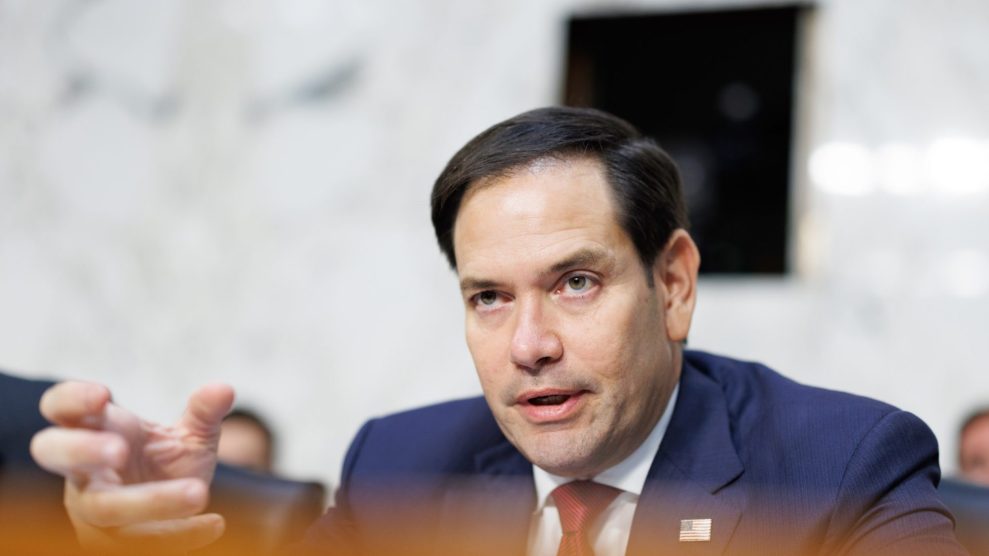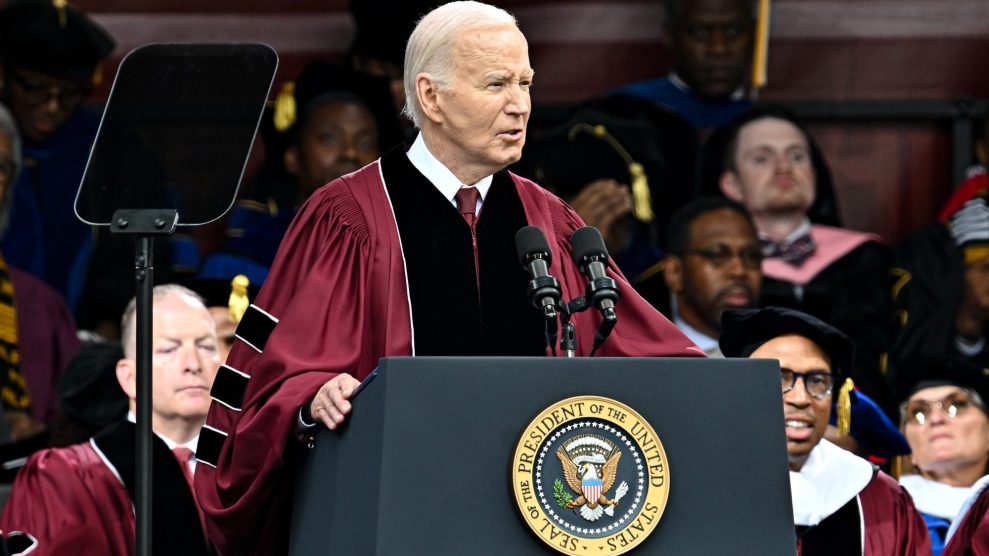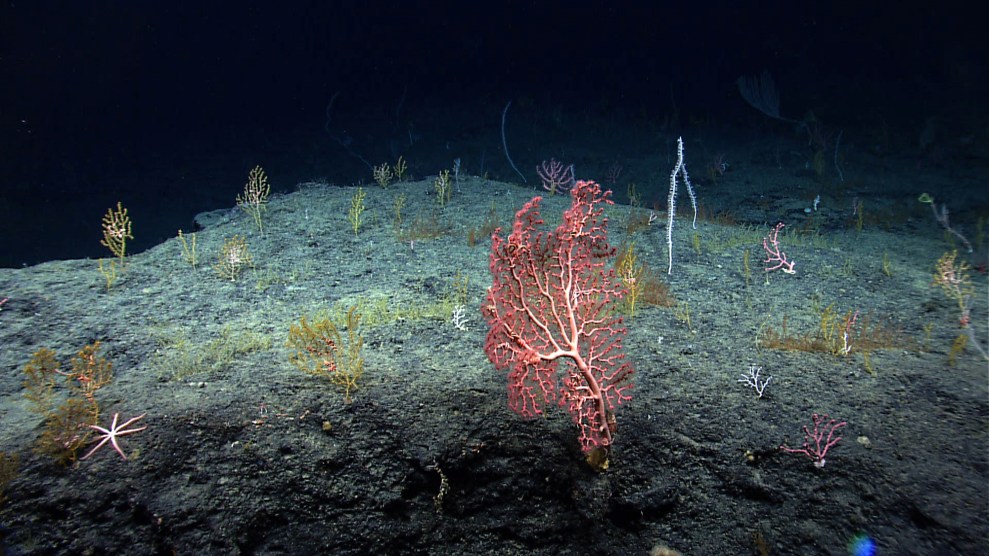We asked a futurist, a MoJo writer, a No Nukes activist, and a weapons security expert:
What is nuclear energy’s place in the future mix of energy sources?
They’ll be checking in on this Blue Marble entry starting Monday to discuss their controversial answers with readers—and each other. Want to talk to Stewart Brand, Judith Lewis, Jonas Siegel, or Harvey Wasserman about their take on nukes? Now’s your chance. Leave a comment below for one of the four guest Blue Marble moderators and they’ll respond.
 Stewart Brand is a futurist with the Global Business Network and founder of the Whole Earth Catalog: I expect that nuclear will grow slowly but steadily in the mix for a couple decades, because it’s a mature technology that provides baseload electricity with minimum carbon emissions. Where it goes after that depends on the rapidity of climate change; the rapidity of other high capacity energy technologies such as space solar, massive electrical storage, high-tech microbe farming, etc; and the usefulness of further nuclear technology, such as decentralized nuclear “batteries,” cheaper reprocessing, fusion, etc. By mid-century or later, depending on how all those work out, nuclear could be heading toward a majority role, like in France now; or it could be headed toward a phase-out by the end of the century, replaced by better things; or the question could seem irrelevant in the face of drastic climate events forcing huge-scale geo-engineering and/or enormous human dieback in the face of collapsing carrying capacity.
Stewart Brand is a futurist with the Global Business Network and founder of the Whole Earth Catalog: I expect that nuclear will grow slowly but steadily in the mix for a couple decades, because it’s a mature technology that provides baseload electricity with minimum carbon emissions. Where it goes after that depends on the rapidity of climate change; the rapidity of other high capacity energy technologies such as space solar, massive electrical storage, high-tech microbe farming, etc; and the usefulness of further nuclear technology, such as decentralized nuclear “batteries,” cheaper reprocessing, fusion, etc. By mid-century or later, depending on how all those work out, nuclear could be heading toward a majority role, like in France now; or it could be headed toward a phase-out by the end of the century, replaced by better things; or the question could seem irrelevant in the face of drastic climate events forcing huge-scale geo-engineering and/or enormous human dieback in the face of collapsing carrying capacity.
 Judith Lewis wrote “The Nuclear Option” for the May/June 2008 issue of Mother Jones: Nuclear energy is far from environmentally benign, but it does have one significant advantage over coal-fired electricity generation: It does not emit carbon dioxide. Even taking into account nuclear’s entire lifecycle, from mining to refining to enrichment of uranium, from plant construction to startup to waste, it adds far less carbon to the atmosphere than coal or natural gas do, and sometimes even beats solar generation. If we accept that catastrophic climate change caused by a buildup of carbon in the atmosphere is our most urgent environmental problem, we should at least consider replacing the coal-fired power that provides half the nation’s electricity with nuclear energy (which currently provides only a fifth).
Judith Lewis wrote “The Nuclear Option” for the May/June 2008 issue of Mother Jones: Nuclear energy is far from environmentally benign, but it does have one significant advantage over coal-fired electricity generation: It does not emit carbon dioxide. Even taking into account nuclear’s entire lifecycle, from mining to refining to enrichment of uranium, from plant construction to startup to waste, it adds far less carbon to the atmosphere than coal or natural gas do, and sometimes even beats solar generation. If we accept that catastrophic climate change caused by a buildup of carbon in the atmosphere is our most urgent environmental problem, we should at least consider replacing the coal-fired power that provides half the nation’s electricity with nuclear energy (which currently provides only a fifth).
But while we consider it, we also have to understand that the nuclear industry also has a lot of problems associated with it, including a compromised federal monitoring agency, the Nuclear Regulatory Commission. And then there’s the waste: It’s becoming ever more clear as the Department of Energy moves ahead with its plans to build a nuclear waste repository in a mountain of porous volcanic rock on earthquake fault that the DOE and Congress made a very bad decision when it chose Yucca Mountain. There needs to be much more public involvement in the process of choosing such sites.
The same goes for just about every part of the nuclear industry’s operations. The industry does seemed poised for a renaissance, and it might deserve one. But if the renaissance happens, people in the U.S. need to get as much information as they can handle about nuclear power; only public participation can force industry and government regulators to do their jobs right.
 Jonas Siegel is editor of the Bulletin of the Atomic Scientists, a media organization that focuses on the intersection of science and security, and has covered nuclear weapons and energy issues for the past five years: Since its inception, nuclear energy has earned legions of supporters. The enormous amount of energy contained in a small amount of nuclear fuel—a pound of uranium 235 has more than 2 million times the energy content of a pound of coal—alone inspired visions of grandeur. Despite its potential, nuclear energy has not overcome a range of risks—safety, nuclear proliferation, and waste—to sustain its growth in the marketplace. If nuclear is going to be a part of the world’s future mix of energy sources, it needs to address these risks head on—and compete economically with other sources.
Jonas Siegel is editor of the Bulletin of the Atomic Scientists, a media organization that focuses on the intersection of science and security, and has covered nuclear weapons and energy issues for the past five years: Since its inception, nuclear energy has earned legions of supporters. The enormous amount of energy contained in a small amount of nuclear fuel—a pound of uranium 235 has more than 2 million times the energy content of a pound of coal—alone inspired visions of grandeur. Despite its potential, nuclear energy has not overcome a range of risks—safety, nuclear proliferation, and waste—to sustain its growth in the marketplace. If nuclear is going to be a part of the world’s future mix of energy sources, it needs to address these risks head on—and compete economically with other sources.
 Harvey Wasserman is a No Nukes activist, the author of Solartopia! Our Green Powered Earth, and edits Nukefree.org: Nuclear power has no place in our future mix of energy sources except as a costly and dangerous curse from previous bad decision-making. The Peaceful Atom is humankind’s most expensive technological failure. To “revisit” this corporate boondoggle is to ignore 50 years of staggering losses. Economically, there is no reason to believe a “new generation” of reactors will be any less disastrous than the last one. The radioactive fuel chain is a major cause of global warming. The ecological, public health and safety aspects of unsolved problems with terrorism, human design and operator error, “routine” radioactive emissions, impossible spent fuel transport and management, weapons proliferation and much more make atomic energy the “Titanic” of energy generation. A dollar invested in efficiency saves seven times the energy a dollar invested in nukes can produce. Wind and solar are already proven and cheaper. Let’s do that instead of re-running the same radioactive horror show.
Harvey Wasserman is a No Nukes activist, the author of Solartopia! Our Green Powered Earth, and edits Nukefree.org: Nuclear power has no place in our future mix of energy sources except as a costly and dangerous curse from previous bad decision-making. The Peaceful Atom is humankind’s most expensive technological failure. To “revisit” this corporate boondoggle is to ignore 50 years of staggering losses. Economically, there is no reason to believe a “new generation” of reactors will be any less disastrous than the last one. The radioactive fuel chain is a major cause of global warming. The ecological, public health and safety aspects of unsolved problems with terrorism, human design and operator error, “routine” radioactive emissions, impossible spent fuel transport and management, weapons proliferation and much more make atomic energy the “Titanic” of energy generation. A dollar invested in efficiency saves seven times the energy a dollar invested in nukes can produce. Wind and solar are already proven and cheaper. Let’s do that instead of re-running the same radioactive horror show.















